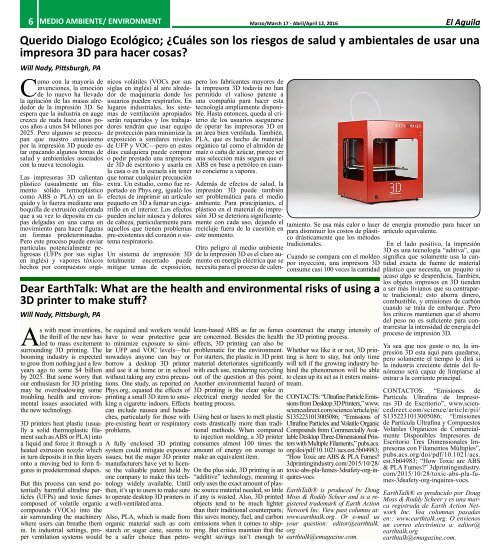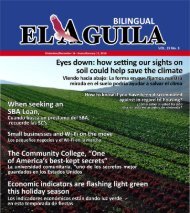El Aguila Magazine – March 16, 2016
Create successful ePaper yourself
Turn your PDF publications into a flip-book with our unique Google optimized e-Paper software.
6 MEDIO AMBIENTE/ ENVIRONMENT<br />
Marzo/<strong>March</strong> 17 - Abril/April 12, 20<strong>16</strong><br />
<strong>El</strong> <strong>Aguila</strong><br />
Querido Dialogo Ecológico; ¿Cuáles son los riesgos de salud y ambientales de usar una<br />
impresora 3D para hacer cosas?<br />
Will Nady, Pittsburgh, PA<br />
Como con la mayoria de<br />
invenciones, la emoción<br />
de lo nuevo ha llevado<br />
la agitación de las masas alrededor<br />
de la impresión 3D. Se<br />
espera que la industria en auge<br />
crezca de nada hace unos pocos<br />
años a unos $4 billones por<br />
2025. Pero algunos se preocupan<br />
que nuestro entusiasmo<br />
por la impresión 3D puede estar<br />
opacando algunos temas de<br />
salud y ambientales asociados<br />
con la nueva tecnología.<br />
nicos volátiles (VOCs por sus<br />
siglas en inglés) al aire alrededor<br />
de maquinaria donde los<br />
usuarios pueden respirarlos. En<br />
lugares industriales, los sistemas<br />
de ventilación apropiados<br />
serán requeridos y los trabajadores<br />
tendrán que usar equipo<br />
de protección para minimizar la<br />
exposición a similares niveles<br />
de UFP y VOC—pero en estos<br />
días cualquiera puede comprar<br />
o pedir prestado una impresora<br />
de 3D de escritorio y usarla en<br />
la casa o en la escuela sin tener<br />
que tomar cualquier precaución<br />
extra. Un estudio, como fue reportado<br />
en Phys.org, igualó los<br />
efectos de imprimir un artículo<br />
pequeño en 3D a fumar un cigarrillo<br />
en el interior. Los efectos<br />
pueden incluir náusea y dolores<br />
de cabeza, particularmente para<br />
aquellos que tienen problemas<br />
pre-existentes del corazón o sistema<br />
respiratorio.<br />
Un sistema de impresión 3D<br />
totalmente encerrado puede<br />
mitigar temas de exposición,<br />
pero los fabricantes mayores de<br />
la impresora 3D todavía no han<br />
permitido el valioso patente a<br />
una compañía para hacer esta<br />
tecnología ampliamente disponible.<br />
Hasta entonces, queda al criterio<br />
de los usuarios asegurarse<br />
de operar las impresoras 3D en<br />
un área bien ventilada. También,<br />
PLA, que es hecho de material<br />
orgánico tal como el almidón de<br />
maíz o caña de azúcar, parece ser<br />
una selección más segura que el<br />
ABS en base a petróleo en cuanto<br />
concierne a vapores.<br />
Además de efectos de salud, la<br />
impresión 3D puede también<br />
ser problemática para el medio<br />
ambiente. Para principiantes, el<br />
plástico en el material de impresión<br />
3D se deteriora significantemente<br />
con cada uso, dejando el<br />
reciclaje fuera de la cuestión en<br />
este momento.<br />
Otro peligro al medio ambiente<br />
de la impresión 3D es el claro aumento<br />
en energía eléctrica que se<br />
necesita para el proceso de calen-<br />
Dear EarthTalk: What are the health and environmental risks of using a<br />
3D printer to make stuff?<br />
Will Nady, Pittsburgh, PA<br />
As with most inventions,<br />
the thrill of the new has<br />
led to mass excitement<br />
surrounding 3D printing. The<br />
booming industry is expected<br />
to grow from nothing just a few<br />
years ago to some $4 billion<br />
by 2025. But some worry that<br />
our enthusiasm for 3D printing<br />
may be overshadowing some<br />
troubling health and environmental<br />
issues associated with<br />
the new technology.<br />
3D printers heat plastic (usually<br />
a solid thermoplastic filament<br />
such as ABS or PLA) into<br />
a liquid and force it through a<br />
heated extrusion nozzle which<br />
in turn deposits it in thin layers<br />
onto a moving bed to form figures<br />
in predetermined shapes.<br />
But this process can send potentially<br />
harmful ultrafine particles<br />
(UFPs) and toxic fumes<br />
composed of volatile organic<br />
compounds (VOCs) into the<br />
air surrounding the machinery<br />
where users can breathe them<br />
in. In industrial settings, proper<br />
ventilation systems would<br />
be required and workers would<br />
have to wear protective gear<br />
to minimize exposure to similar<br />
UFP and VOC levels—but<br />
nowadays anyone can buy or<br />
borrow a desktop 3D printer<br />
and use it at home or in school<br />
without taking any extra precautions.<br />
One study, as reported on<br />
Phys.org, equated the effects of<br />
printing a small 3D item to smoking<br />
a cigarette indoors. Effects<br />
can include nausea and headaches,<br />
particularly for those with<br />
pre-existing heart or respiratory<br />
problems.<br />
A fully enclosed 3D printing<br />
system could mitigate exposure<br />
issues, but the major 3D printer<br />
manufacturers have yet to license<br />
the valuable patent held by<br />
one company to make this technology<br />
widely available. Until<br />
then, it’s up to users to make sure<br />
to operate desktop 3D printers in<br />
a well-ventilated area.<br />
leum-based ABS as far as fumes<br />
are concerned. Besides the health<br />
effects, 3D printing can also be<br />
problematic for the environment.<br />
For starters, the plastic in 3D print<br />
material deteriorates significantly<br />
with each use, rendering recycling<br />
out of the question at this point.<br />
Another environmental hazard of<br />
3D printing is the clear spike in<br />
electrical energy needed for the<br />
heating process.<br />
Using heat or lasers to melt plastic<br />
costs drastically more than traditional<br />
methods. When compared<br />
to injection molding, a 3D printer<br />
consumes almost 100 times the<br />
amount of energy on average to<br />
make an equivalent item.<br />
On the plus side, 3D printing is an<br />
“additive” technology, meaning it<br />
only uses the exact amount of plastic<br />
source material needed, so little<br />
if any is wasted. Also, 3D printed<br />
objects tend to be much lighter<br />
than their traditional counterparts;<br />
this saves money, fuel, and carbon<br />
emissions when it comes to shipping.<br />
But critics maintain that the<br />
weight savings isn’t enough to<br />
Also, PLA, which is made from<br />
organic material such as corn<br />
starch or sugar cane, seems to<br />
be a safer choice than petrotamiento.<br />
Se usa más calor o laser<br />
para disminuir los costos de plástico<br />
drásticamente que los métodos<br />
tradicionales.<br />
Cuando se compara con el moldeo<br />
por inyección, una impresora 3D<br />
consume casi 100 veces la cantidad<br />
Las impresoras 3D calientan<br />
plástico (usualmente un filamento<br />
sólido termoplástico<br />
como ABS o PLA) en un líquido<br />
y lo fuerza mediante una<br />
boquilla de extrusión calentada<br />
que a su vez lo deposita en capas<br />
delgadas en una cama en<br />
movimiento para hacer figuras<br />
en formas predeterminadas.<br />
Pero este proceso puede enviar<br />
partículas potencialmente peligrosas<br />
(UFPs por sus siglas<br />
en inglés) y vapores tóxicos<br />
hechos por compuestos orgácounteract<br />
the energy intensity of<br />
the 3D printing process.<br />
Whether we like it or not, 3D printing<br />
is here to stay, but only time<br />
will tell if the growing industry behind<br />
the phenomenon will be able<br />
to clean up its act as it enters mainstream.<br />
CONTACTS: “Ultrafine Particle Emissions<br />
from Desktop 3D Printers,” www.<br />
sciencedirect.com/science/article/pii/<br />
S1352231013005086; “Emissions of<br />
Ultrafine Particles and Volatile Organic<br />
Compounds from Commercially Available<br />
Desktop Three-Dimensional Printers<br />
with Multiple Filaments,” pubs.acs.<br />
org/doi/pdf/10.1021/acs.est.5b04983;<br />
“How Toxic are ABS & PLA Fumes?<br />
3dprintingindustry.com/2015/10/28/<br />
toxic-abs-pla-fumes-3dsafety-org-inquires-vocs.<br />
EarthTalk® is produced by Doug<br />
Moss & Roddy Scheer and is a registered<br />
trademark of Earth Action<br />
Network Inc. View past columns at:<br />
www.earthtalk.org. Or e-mail us<br />
your question: editor@earthtalk.<br />
org<br />
earthtalk@emagazine.com.<br />
de energía promedio para hacer un<br />
artículo equivalente.<br />
En el lado positivo, la impresión<br />
3D es una tecnología “aditiva”, que<br />
significa que solamente usa la cantidad<br />
exacta de fuente de material<br />
plástico que necesita, un poquito si<br />
acaso algo se desperdicia. También,<br />
los objetos impresos en 3D tienden<br />
a ser más livianos que su contraparte<br />
tradicional; esto ahorra dinero,<br />
combustible, y emisiones de carbón<br />
cuando se trata de embarque. Pero<br />
los críticos mantienen que el ahorro<br />
del peso no es suficiente para contrarrestar<br />
la intensidad de energía del<br />
proceso de impresión 3D.<br />
Ya sea que nos guste o no, la impresión<br />
3D esta aquí para quedarse,<br />
pero solamente el tiempo lo dirá si<br />
la industria creciente detrás del fenómeno<br />
será capaz de limpiarse al<br />
entrar a la corriente principal.<br />
CONTACTOS: “Emisiones de<br />
Partícula Ultrafina de Impresoras<br />
3D de Escritorio”, www.sciencedirect.com/science/article/pii/<br />
S1352231013005086; “Emisiones<br />
de Partícula Ultrafina y Compuestos<br />
Volátiles Orgánicos de Comercialmente<br />
Disponibles Impresores de<br />
Escritorio Tres Dimensionales Impresoras<br />
con Filamentos Múltiples”,<br />
pubs.acs.org/doi/pdf/10.1021/acs.<br />
est.5b04983; “How Toxic are ABS<br />
& PLA Fumes?” 3dprintingindustry.<br />
com/2015/10/28/toxic-abs-pla-fumes-3dsafety-org-inquires-vocs.<br />
EarthTalk® es producido por Doug<br />
Moss & Roddy Scheer y es una marca<br />
registrada de Earth Action Network<br />
Inc. Vea columnas pasadas<br />
en:: www.earthtalk.org. O envíenos<br />
un correo electrónico a: editor@<br />
earthtalk.org<br />
earthtalk@emagazine.com.
















